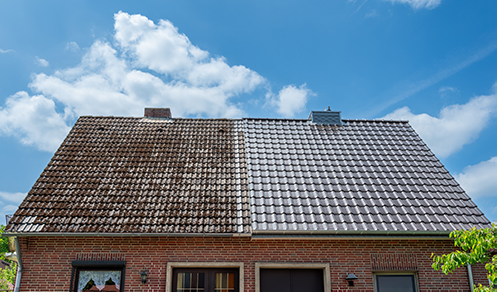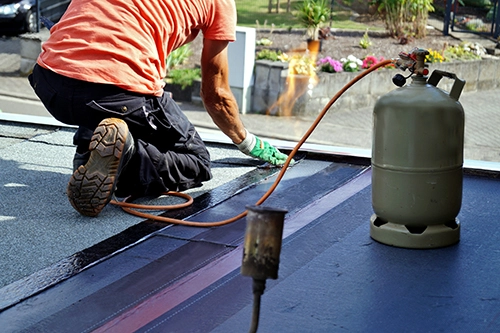- About Us
- Services
- Blog
- Contact
Need a quote?
When it comes to home improvements, roof maintenance can be easy to overlook or delay. That being said, many people don’t realise just what a difference moss removal and roof cleaning can make to the overall look of their home, not to mention the extent to which regular cleaning can minimise roof damage.
But what makes moss such a problem for roofs in the UK? And how often should you be arranging to have your roof cleaned?




It’s easy to underestimate the importance of moss removal and roof cleaning, especially if you don’t consider the long-term effects of moisture damage on the property. Over time, damage from wind and moisture can spread, causing further damage to the roof and, if you’re not careful, leading to moisture leaking through into the floors below.
The real danger of this type of damage is that, if you don’t keep an eye on it, it can get far worse over time, inflating a small problem into a larger one and costing you more money in the long run. That’s why we recommend that you make sure to have your roof cleaned once every few years to keep it in the best possible condition.
As a rule, it’s best to arrange moss removal and roof cleaning during the spring and summer months. During the winter, roofs can be slippery and lighting conditions are not always ideal meaning that work can take longer to complete. Furthermore, when winter roof repairs are done, they’re often emergency measures taken at short notice in response to damage, making them harder to arrange in advance.
Of course, if your roof is damaged it can be hard to identify the extent of the problem. That’s why, here at Environ, we use drone surveys to get a clear picture of the situation.
A drone survey can give us a lot of information about how much work (if any) is required. Sometimes that might just be a cleanup - others it might mean more substantial repairs. Either Way, it’s best to know sooner rather than later.
Think your roof could do with a glow-up? Get in touch with us today at 020 3971 1901 or by emailing info@environroofingservices.co.uk and our friendly and helpful team will be delighted to talk through the problem and how we can help.
It depends on the construction, but the minimum weight a flat roof must be capable of bearing is 300lbs. This refers to a concentrated weight where a load is positioned on just one area of the roof. So, for example, a commercial flat roof can approximately support a 300lb HVAC unit in a 2.5×2.5ft single space.
If you opt for a flat roof anywhere on your property, remember that it comes with a need for proper maintenance. Low-slope roofing London-wide should be checked every six months or so, or after spells of bad weather, to spot any signs of damage. No matter how small, these should be addressed before they escalate. Remove any debris (leaves, twigs and so on) regularly to avoid these blocking the gutters and allowing water to pool and stand on the roof.
If there are trees in the close vicinity, keep them cut back to reduce the amount of foliage that falls on your flat roof. And check internally for signs of moisture, dampness or water damage on a regular basis. Spotting problems early means resolving them will be cheaper in the long run.

Building a flat roof can be done in three ways. The simplest and most cost-effective choice for levelled roofing London-wide is to construct a warm roof where a roofing membrane is placed over the insulation that keeps the timber structure warm. Another option is to create a cold roof where insulation is positioned between the rafters under the ply roof covering. This is commonly applied to flat-roofed extensions.
The third method is the hybrid roof that contains diverse elements. Their designs require a gap of ventilation above a warm roof to prevent excess moisture within the roof structure.
If you’re looking for flat roofing local contractors, don’t just select the first firm you come across. Find a roofing company that’s been in business for a while and can demonstrate a good track record in installing, repairing, and replacing flat roofs specifically. Ask for recommendations from your own network or from a local trade association. If you need refurbishment work done to 50% or more of your roof, you’ll need a roofing contractor who can self-certify their work under the Competent Person Scheme. Otherwise, the Building Control department at your local authority will need to approve the job before it begins.
Ask whether they are covered by liability insurance and how long they’ll guarantee the work they will carry out. And never just opt for the cheapest quote unless you’re quite sure they’re the best company for the job. You can’t afford to compromise on your roof as the structural integrity of your property depends on it.
Ensuring your flat roof will comply with building regulations before installation can save property owners time, money and stress. First, the roof must have a slope of around 1:80, with water draining away to one or two roof edges. Waterproofing must be extended up to the adjacent walls with at least 150 mm from the surface of the roof.
Contractors must install ventilation in cold roofs. For warm roofs, the deck must be bonded with a VCL. The roof should have the capacity to withstand strong winds and be sturdy enough to take an individual’s weight. Finally, check whether planning permission is needed. Typically, this is only required if you live in a conservation area or a listed building, or are making significant changes to an existing roof.
If you’re looking for top roofing solutions at competitive rates, check out our range of roofing services at Environ Roofing Company London. To get started, call one of our representatives today!

